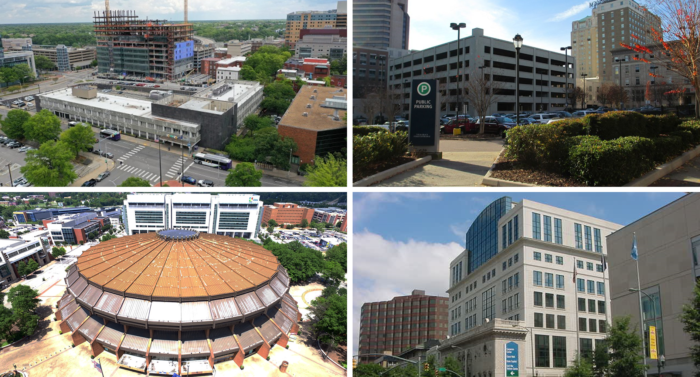
Four of the city-owned properties set to be declared surplus, clockwise from top left: the Public Safety Building at Ninth and Leigh streets; the parking lot at 609 E. Grace St.; the Theatre Row Building on Broad Street; the Coliseum. (BizSense file and submitted photos)
A significant step in the City of Richmond’s plan to solicit new development proposals for properties that were part of the failed Navy Hill plan is set to be put into motion this week.
Administrators are moving forward with City Council’s request to declare the bulk of those properties, including the Richmond Coliseum, as surplus properties – a move that’s required by city code before council can issue a request for proposals (RFP) or consider unsolicited offers, of which the city has received two.
A resolution before the Land Use, Housing and Transportation Standing Committee on Tuesday would declare surplus the Coliseum property, the Public Safety Building parcel at 500 N. 10th St. (the focus of one of the offers), and the parking lot across Clay Street from the John Marshall Courts Building that the Navy Hill plan had eyed for a new GRTC transfer station.
Also included are two city-owned sites south of Broad Street that were initially part of Navy Hill but later removed: a parking lot at 401 E. Broad St., across from the Greater Richmond Convention Center; and the bulk of the city block at 609 E. Grace St., across from the Carpenter Theatre-anchored Dominion Energy Center.
Rounding out the properties is the Theatre Row Building at 730 E. Broad St., the only property involved in the surplus resolution that was not tied to Navy Hill. The 10-story, 166,000-square-foot office building houses the city’s Richmond Gas Works public utilities department, as well as space used by VCU’s School of Medicine.
The resolution, which the committee would send back to council for final approval, states that the goal of declaring the properties surplus is to facilitate their purchase and taxable development. Adoption would allow the city to issue one or multiple RFPs that would likewise need to be reviewed by the committee, though an explainer accompanying the document notes other requirements that would need to be met.
Those include development of a small area plan and appraisals of each of the properties involved, as a majority of council requested in February in a resolution that preceded the Navy Hill vote. The small area plan would need to be completed before any RFP could be issued, as the explainer notes that public input and recommendations from that plan would be used to draft any RFP.
The memo states that the city is in the process of conducting the appraisals and engaging the public to craft the plan, which council members have said could be folded into the city’s Richmond 300 master plan update. That update had been scheduled for adoption next month, according to the Richmond 300 website, but now is slated for September. A draft of the plan is to be released later this month.
Offers on the table
An RFP would open the door for council to be able to formally consider two offers that have been made on Navy Hill properties in recent months.
Shortly after the $1.5 billion project was voted down in February, the city received an offer from D.C.-based Douglas Development to purchase nearly 15 acres of the Navy Hill project area for $15 million in cash. The company, which has ramped up its local activity of late, said it planned to refurbish the shuttered Coliseum and develop the rest of the land with a mix of residential, office, retail and hotel uses.
This month, another offer came in, this one from Capital City Partners, the development team that was enlisted for Navy Hill. The offer is solely for the Public Safety Building property at 500 N. 10th St., which the group proposes to redevelop as a mixed-use office complex, highlighted with a 20-story tower that would be leased by VCU Health.
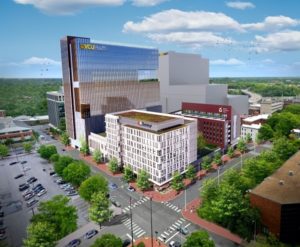
A rendering of the proposed office tower and complex that would replace the Public Safety Building. (Courtesy Capital City Partners)
Where Douglas’s offer didn’t get into specifics, CCP’s proposal goes into considerable detail and was based on an appraisal by CBRE. That appraisal put the land value of the 3-acre site, once it’s made “shovel-ready” after the Public Safety Building is demolished, at $8.5 million.
Because CCP’s offer assumes costs of demolition and infrastructure improvements to ready the site and extend Clay Street between Ninth and 10th streets, estimated values of that work were deducted from the $8.5 million land value, resulting in CCP’s proposed purchase price of about $3.17 million.
Before council can act on either offer, city code requires that it first solicit additional offers, either through an RFP or an invitation for bids.
Buildings beyond Navy Hill
New to the surplus properties discussion is the Theatre Row Building at 730 E. Broad St. The memo from administrators to council, which introduced and referred the resolution to the committee in a special meeting April 27, states that the building was included due to its potential market value.
The latest city assessment valued the 0.38-acre property at $28.28 million, property records show. An appraisal would determine a different value for the building based on factors beyond the property’s tax assessment.
The Grace Street site, which includes multiple parcels, had been eyed for development prior to Navy Hill. In 2016, a development group that was behind the Turning Basin building in Shockoe Slip proposed an $86 million mixed-use development for the Grace Street site that never got off the ground.
The memo from administrators to council also notes that the city owns other properties that could likewise be deemed surplus and offered for sale through future resolutions. To that end, the city is conducting an analysis of other city-owned properties for a “Real Estate Strategies Plan” that administrators aim to present to council by Oct. 1 of this year.
The memo states that the city should leverage the sale and development of the surplus properties not only to create additional tax revenue but also to achieve goals such as more income-based housing, Class A office space to attract and retain companies, hotel rooms to support the convention center and tourism, and new jobs and training for citizens, among other priorities.
Such goals can be achieved, the memo adds, with the resolution’s adoption, which is being recommended now to allow the process “to move forward without undue delay.”
The memo was drafted by Matthew Welch, the city’s senior policy advisor for economic development and planning, and signed off on by Economic Development Director Leonard Sledge, Acting Chief Administrative Officer Lenora Reid, Deputy CAO Sharon Ebert and Mayor Levar Stoney.

Four of the city-owned properties set to be declared surplus, clockwise from top left: the Public Safety Building at Ninth and Leigh streets; the parking lot at 609 E. Grace St.; the Theatre Row Building on Broad Street; the Coliseum. (BizSense file and submitted photos)
A significant step in the City of Richmond’s plan to solicit new development proposals for properties that were part of the failed Navy Hill plan is set to be put into motion this week.
Administrators are moving forward with City Council’s request to declare the bulk of those properties, including the Richmond Coliseum, as surplus properties – a move that’s required by city code before council can issue a request for proposals (RFP) or consider unsolicited offers, of which the city has received two.
A resolution before the Land Use, Housing and Transportation Standing Committee on Tuesday would declare surplus the Coliseum property, the Public Safety Building parcel at 500 N. 10th St. (the focus of one of the offers), and the parking lot across Clay Street from the John Marshall Courts Building that the Navy Hill plan had eyed for a new GRTC transfer station.
Also included are two city-owned sites south of Broad Street that were initially part of Navy Hill but later removed: a parking lot at 401 E. Broad St., across from the Greater Richmond Convention Center; and the bulk of the city block at 609 E. Grace St., across from the Carpenter Theatre-anchored Dominion Energy Center.
Rounding out the properties is the Theatre Row Building at 730 E. Broad St., the only property involved in the surplus resolution that was not tied to Navy Hill. The 10-story, 166,000-square-foot office building houses the city’s Richmond Gas Works public utilities department, as well as space used by VCU’s School of Medicine.
The resolution, which the committee would send back to council for final approval, states that the goal of declaring the properties surplus is to facilitate their purchase and taxable development. Adoption would allow the city to issue one or multiple RFPs that would likewise need to be reviewed by the committee, though an explainer accompanying the document notes other requirements that would need to be met.
Those include development of a small area plan and appraisals of each of the properties involved, as a majority of council requested in February in a resolution that preceded the Navy Hill vote. The small area plan would need to be completed before any RFP could be issued, as the explainer notes that public input and recommendations from that plan would be used to draft any RFP.
The memo states that the city is in the process of conducting the appraisals and engaging the public to craft the plan, which council members have said could be folded into the city’s Richmond 300 master plan update. That update had been scheduled for adoption next month, according to the Richmond 300 website, but now is slated for September. A draft of the plan is to be released later this month.
Offers on the table
An RFP would open the door for council to be able to formally consider two offers that have been made on Navy Hill properties in recent months.
Shortly after the $1.5 billion project was voted down in February, the city received an offer from D.C.-based Douglas Development to purchase nearly 15 acres of the Navy Hill project area for $15 million in cash. The company, which has ramped up its local activity of late, said it planned to refurbish the shuttered Coliseum and develop the rest of the land with a mix of residential, office, retail and hotel uses.
This month, another offer came in, this one from Capital City Partners, the development team that was enlisted for Navy Hill. The offer is solely for the Public Safety Building property at 500 N. 10th St., which the group proposes to redevelop as a mixed-use office complex, highlighted with a 20-story tower that would be leased by VCU Health.

A rendering of the proposed office tower and complex that would replace the Public Safety Building. (Courtesy Capital City Partners)
Where Douglas’s offer didn’t get into specifics, CCP’s proposal goes into considerable detail and was based on an appraisal by CBRE. That appraisal put the land value of the 3-acre site, once it’s made “shovel-ready” after the Public Safety Building is demolished, at $8.5 million.
Because CCP’s offer assumes costs of demolition and infrastructure improvements to ready the site and extend Clay Street between Ninth and 10th streets, estimated values of that work were deducted from the $8.5 million land value, resulting in CCP’s proposed purchase price of about $3.17 million.
Before council can act on either offer, city code requires that it first solicit additional offers, either through an RFP or an invitation for bids.
Buildings beyond Navy Hill
New to the surplus properties discussion is the Theatre Row Building at 730 E. Broad St. The memo from administrators to council, which introduced and referred the resolution to the committee in a special meeting April 27, states that the building was included due to its potential market value.
The latest city assessment valued the 0.38-acre property at $28.28 million, property records show. An appraisal would determine a different value for the building based on factors beyond the property’s tax assessment.
The Grace Street site, which includes multiple parcels, had been eyed for development prior to Navy Hill. In 2016, a development group that was behind the Turning Basin building in Shockoe Slip proposed an $86 million mixed-use development for the Grace Street site that never got off the ground.
The memo from administrators to council also notes that the city owns other properties that could likewise be deemed surplus and offered for sale through future resolutions. To that end, the city is conducting an analysis of other city-owned properties for a “Real Estate Strategies Plan” that administrators aim to present to council by Oct. 1 of this year.
The memo states that the city should leverage the sale and development of the surplus properties not only to create additional tax revenue but also to achieve goals such as more income-based housing, Class A office space to attract and retain companies, hotel rooms to support the convention center and tourism, and new jobs and training for citizens, among other priorities.
Such goals can be achieved, the memo adds, with the resolution’s adoption, which is being recommended now to allow the process “to move forward without undue delay.”
The memo was drafted by Matthew Welch, the city’s senior policy advisor for economic development and planning, and signed off on by Economic Development Director Leonard Sledge, Acting Chief Administrative Officer Lenora Reid, Deputy CAO Sharon Ebert and Mayor Levar Stoney.

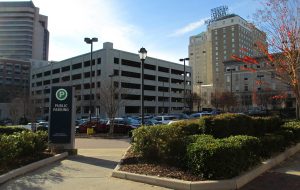
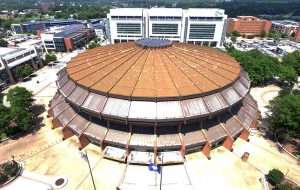
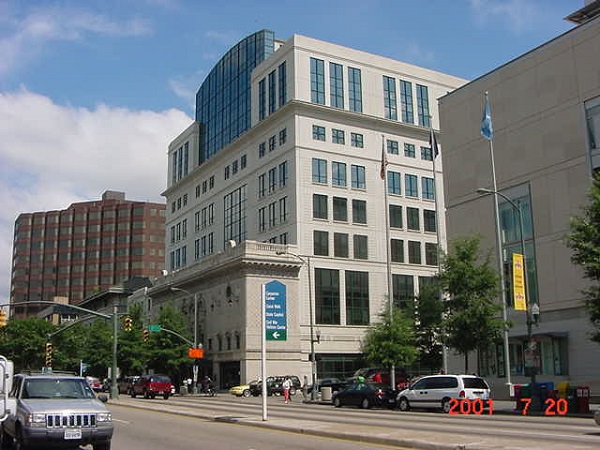


Fabulous update. Thank you to those City Council members who represented our tax payers’ best interest by admantly rejecting Navy Hill and realizing there was a better, more equitable, and lucrative approach for taxpayers.
I want to specifically express toward Hon. Kim Gray. That TIF would have definitely put us in a negative position and she took a hard stand, alas it was an honorable stand.
Let’s do this Richmond! Bring on the development, but in a way that allows all of us to be in it together.
It would be great to see all these properties off city books and paying tax. The city needs the money, and downtown needs the development
Well I can’t seem to get over the “Folded into the Richmond 300” update. Why has that process had any really progress? The master plan/ Richmond 300 is officially three years old in July and the staff were hired and the process started a year and a half before Jones 2nd term actually ended. 4 1/2 years later and we still don’t have a draft master plan. As a former city employee it took about 5-10 years for city to surplus and sale most city buildings. Im betting by 2025 they MIGHT be ready to close on the sale of… Read more »